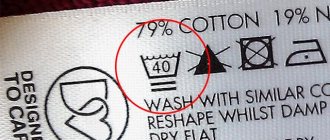Fashion is cyclical, so now the well-known down scarves and shawls, including the creations of Orenburg needlewomen, have become popular again. Products made from down are not only a stylish accessory, but also excellently retain heat even in severe frosts. The scarves are voluminous, almost weightless, and shawls like “Gossamer” are a real masterpiece of handcraft.
Owning such a beautiful item is not only about being able to wear it and combine it with your wardrobe. Caring for a down scarf must be special and very delicate, so in order to wash a down scarf at home, bleach it (in the case of items made of light wool) and dry it, you need to know some subtleties and nuances of care.
Washing rules
A down scarf is a very soft and delicate product that is knitted by hand using a special technology. Therefore, care is required just as delicate. Ideally, it is better not to wash down items at all, because detergents and moisture affect the appearance. But, since in the case of a light scarf, the procedure is inevitable, this should be done at least rarely, for example, once a season.
Due to the capriciousness of the material, it is necessary to wash the down scarf only by hand. Chemical or dry cleaning is also possible, but washing it in an automatic machine is not a good idea. The mechanical impact of the drum is extremely destructive for a down shawl.
It is important to take into account the basic rules:
- Preferably dry cleaning. Do not rush to wash the scarf if you can clean the dirt with a dry brush or rag;
- wash the scarf only delicately by hand without actively washing problem areas or rough squeezing;
- use of gentle specialized liquid products for the care of wool products;
- compliance with temperature conditions. Down does not tolerate hot water, and cold water is not effective for removing dirt, so you can wash it in warm water 35-40°C;
- spin The scarf is not twisted, but gently wrung out to avoid deformation or breaking of the thread. Drying is done naturally in a well-ventilated area;
- Rinse thoroughly to remove as much detergent as possible.
Preparation
Before washing a down shawl, it is inspected for dirt. If they can be removed with a dry soft brush, washing is not necessary. Local stain removal is also possible. For example, traces of blood or wine can be removed with an aspirin tablet. The resulting paste is applied to the stained area, left, and then removed.
Since most products have quite a long fluff, before washing them, the scarf or shawl must be carefully combed with a wooden comb or comb with rounded teeth at the ends. The item is carefully spread on a horizontal surface and the fluff is carefully combed, trying not to touch the base and loops.
Choice of product
You can wash a down shawl with liquid detergents for woolen items. Powder in this case is far from the best option, since the granules are poorly washed out of the fibers and can leave streaks.
Detergent options:
- gel. Preference should be given to products for delicate and woolen fabrics;
- liquid soap with neutral pH. Liquid or bar soap for children, crushed on a fine grater, is also suitable;
- shampoo. Since it forms a lot of foam, it is added in small quantities.
Attention! Laundry soap is not suitable in this case, because... may change the color of the product.
To soften, add freshness and eliminate unpleasant odors, you can use fabric softener in the last rinse.
Handwash
The optimal way to wash an Orenburg scarf made of goat fluff is by hand, since even the most delicate mode in an automatic washing machine can damage the delicate structure of the knitting, and the fluff itself will hopelessly lose its volume.
Procedure:
- Fill a large basin or bathtub with warm water (up to 40°C). At the same time, we must not forget that the entire process must take place in water of the same temperature.
- Dissolve the selected detergent according to the instructions. If it is shampoo or liquid soap, then a couple of tablespoons per 15-20 liters of water is enough.
- Soak the scarf for half an hour, it is important that it is completely covered with liquid.
- Using gentle movements, squeeze out the scarf as if you were making a snowball or a ball, do not twist or stretch.
- Rinse the shawl in warm water, changing it until it becomes clear. You can add conditioner during the final rinse to add fragrance.
Tip : to make the fluff shiny and soft, you can add a little acetic acid or strained lemon juice to the final rinse water.
Hand washing of a scarf should be based on light squeezing, do not actively rub or wash, use hard brushes or aggressive detergents to remove stains.
Attention! Do not pour detergent directly onto the scarf, or direct a stream of water onto the down product.
Machine washable
It is highly undesirable to use the machine in this case. But if it is not possible to wash a down product in any other way, you should adhere to these recommendations:
- use liquid detergent:
- place the shawl in a special mesh bag to minimize friction of the fiber on the drum;
- select mode settings with temperatures up to 40°C, minimum speed, no spin. You can use the "Wool" or "Delicate" mode.
What to wash: the right choice of detergents
The Orenburg down scarf is a delicate product. You should not use regular phosphate powder to wash it. He can ruin it forever. As a detergent you can use:
- Special gel for washing woolen items. In stores you can purchase a gel or liquid designed for washing woolen or delicate items. Don't buy powder because it will be difficult to rinse out. Particles easily get stuck between the fibers.
- Shampoo. The shampoo you use to wash your hair can be used for washing. Add only a small amount, otherwise it will be difficult to rinse.
- Baby soap. Baby soap usually works well for light stains. It needs to be grated. The shavings should be diluted in water, and the scarf or shawl should be washed in the prepared solution.
- Liquid soap. Do not use soaps containing bright colors or strong chemical fragrances as they may damage the accessory.
Advice! Use conditioner to rinse. It will return the scarf softness and fluffiness, and add a pleasant aroma.
Proper drying
Washing a down scarf is half the battle; you also need to dry it properly. The fact is that such things have the unpleasant property of deforming when wet, stretching and losing their correct geometric shape. To prevent this from happening, it is better to use a frame that fits the size of the shawl. This is a regular slatted design with fastenings for fixing the scarf around the perimeter. You can either purchase it in a store or make it yourself from scrap materials.
Procedure:
- The frame is placed on a horizontal surface, the pressed product is straightened so that its edges coincide with the edges of the frame.
- Using fishing line or twine, the scarf is tied at regular intervals to the frame fastenings.
- When the shawl is stretched and secured, it is left to dry in a warm, ventilated area until completely dry.
There is a less painstaking method of drying when there is no frame or the ability to make and position it:
- Oilcloth or polyethylene is spread on a flat surface.
- A towel, a piece of sheet or thick cotton fabric to the size of the scarf is spread on top.
- The stole is placed on the fabric, straightened (do not stretch), the ends are secured with pins and left to dry, periodically turning over and changing the lining to a dry one if necessary.
Washing recommendations and possible errors
A down scarf should be washed and rinsed at the same temperature. It is especially important to take this into account when machine washing - you cannot set it more than 30 degrees.
Hot water causes the fluff to fall off. But it’s also not advisable to wash with cold water, it simply won’t wash away the dirt.
People often make mistakes when washing down products. They lead to stretching of the item, deformation of the pattern, and the disappearance or shedding of fluff.
You need to know what is not recommended to do:
- wash in hot water;
- use washing powder or bleach;
- pour detergent onto the handkerchief;
- rub, pull the fabric, brush;
- twist or lift by the ends;
- place the item under running water.
How to bleach yellowness from a down scarf?
Unfortunately, white things made from natural wool and down lose their snow-whiteness over time and begin to turn yellow for many reasons. This is both the influence of external factors and the property of wool to age. Therefore, when the first signs of yellowness appear, it becomes necessary to wash and bleach them. And just for such cases there are several ways.
Important : when removing yellowness, you should absolutely not use chlorine-based bleach!
At home, you can bleach a white down scarf using the following means:
- hydrogen peroxide;
- ammonia;
- hydroperite tablets;
- oxygen-containing industrial bleach.
For bleaching, prepare a solution in warm water with the addition of a peroxide-ammonia or hydroperite-ammonia mixture. In this case, you need to take into account the total weight of the shawl, because... For every 100 g of downy item, take 20 g of 3% peroxide or 5 tablets of hydroperite (do not use at the same time).
After complete dissolution of one or another product, ammonia is added at the rate of 10 tsp. for 10 liters of water. Next, the scarf is soaked in the solution for several hours, while the water temperature should be maintained at the same level, and the downy item itself should be completely covered with the solution. After bleaching, the scarf should be rinsed and dried.
Advice! To maintain the water temperature, the container should be periodically heated or placed on a heating pad.
When using oxygen-containing bleach, follow the instructions on the product package. In this case, the process is simpler and faster, and due to the fact that the components of the product in the process break down into oxygen and hydrogen peroxide, the yellowness will disappear. However, you should choose liquid products and not use them frequently to avoid damage to the fibers. You can bleach a downy web scarf using any of the following methods.
What substances harm the product?
You can wash your shawl only with mild detergents – liquid soap or gel. Washing powder with optical brightener is not recommended; its solid particles are difficult to remove from the fibers when rinsing. The powder will make the item hard and pellets will form. To remove old stains, do not use products containing chlorine or professional stain removers. Aggressive substances can destroy thin threads, making a hole, then the product will have to be thrown away. Using laundry soap, even in the form of shavings, negatively affects the color. Yellowness will appear, causing the item to lose its attractiveness. Exposure to alkali causes the delicate material to become thinner.
Improper drying and prolonged exposure to sunlight can be harmful. Vertical drying near heat sources can lead to loss of shape, creates a fire hazard, and is easily flammable. And sunlight causes the color to fade.
Cleaning can only take place at home; detergents used in professional dry cleaners are not suitable for such delicate fabrics. The sequence of actions should be strictly followed: carefully prepare the product before the procedure, select the appropriate product, rinse and dry. If you follow the rules and treat them with care, the washed item will become like new and will delight you with soft, fluffy snow-white fluff for a long time.
The article has been verified by the editors
How to fluff a product after washing?
The spectacular appearance of a goat down scarf is created by its amazing fluffiness. Over time, hairs can peel off, roll off, and form into clumps. As a result, both the tactile properties of the product and its appearance will deteriorate.
You can keep the scarf airy and fluff it up in this unusual way:
- Wash the shawl the correct way.
- Carefully place the slightly damp product in a plastic bag and tie it.
- Place in the freezer for several hours, periodically removing and shaking the bag.
- Remove from the freezer, spread on a flat surface, shake out and leave to dry naturally.
- After complete drying, brush with a wooden brush.
Due to rapid freezing, the moisture in the fibers turns into ice, which loosens the wool fibers, making them more airy and fluffy.
Preparing the scarf itself
Before you start washing your favorite down scarf, you need to do some preparatory work. To begin with, you should carefully comb the product. This can be done in 2 stages: with a massage brush with thick teeth, and then with a regular comb. If you don’t do this, then after washing your stole will become tangled and it will be difficult to restore it to its original form.
Then you need to thread a thin fishing line into the teeth that run along the edge of the shawl and tie its ends. The length of the fishing line must be greater than the total length of all sides of the product. You will then use this line to pull the scarf onto the frame so that it dries evenly.
Care Tips
In order for a down scarf to please the eye, provide warmth in severe frosts and bring joy to its owner, it is important to wear and store it correctly. Like any delicate thing, a down shawl loves care and respect:
- It is better to store a down scarf in a special non-woven case, box or bag separately from other accessories;
- Pooh loves air. Periodically air the scarf on the balcony or street: this will remove unpleasant odors and fluff up the wool fibers;
- creases can be removed by lightly spraying with water from a spray bottle and then drying;
- never dry a scarf on a line, in a vertical position, do not twist the product;
- To prevent the appearance of moths and maintain a pleasant smell, use special aromatic sachets;
- To prevent bends from appearing on the scarf during storage, roll it;
- Since down absorbs various odors well, you should not store the scarf near the kitchen, smoking areas and similar areas.
Is it possible to wash a shawl in a washing machine?
We hasten to warn you that washing down products in a machine has an extremely negative effect on the quality of the material. But if such a situation does occur, and you simply need to use automation, then be extremely careful. Carefully study how to wash a shawl using this method. And also strictly follow all the rules and scrupulously study the composition of the drugs used.
Suitable detergents
The ideal products for use in the machine are liquid industrial concentrates for washing wool. They foam moderately and are gentle on the material, removing dirt from it. Such solutions are developed taking into account the “capriciousness” of wool and do not reduce its quality if the instructions are strictly followed.
Caution: delicate down fabrics are not dry cleaned. It significantly reduces the quality and service life.
Washing mode
The only acceptable mode is “delicate”, with the mandatory disabling of the spin and drying functions and minimal heating of the water. It is with this method that the scarf hardly dangles in the drum (which often leads to further deformation), and the process approaches manual, careful washing.
None of the “wool” and “hand wash” functions are categorically suitable. Their negative impact on the canvas is noted.
They don’t just put a handkerchief in a drum. To do this, you need to use a washing bag or cover that fastens tightly and protects the item from mechanical impact.
Water temperature
The ideal temperature for washing down products does not exceed 35 degrees. Otherwise, uneven shrinkage occurs and loss of the original appearance and quality. Professionals recommend observing the temperature regime of the wash itself and subsequent rinses. In this case, your shawl will not stretch, will not wrinkle, and will retain its original fluffiness and airiness for many years.
When do you need dry cleaning and when do you need a full wash?
With frequent wear, the down covering and the wool thread itself can become covered with dust and dirt. The shawl actively absorbs all kinds of odors, so it is recommended to protect it from cigarette smoke and strong perfume .
If there are no visible stains or local darkening on the scarf, and there is no unpleasant odor, then you can limit yourself to periodic dry cleaning. If the shawl gets wet, it must first be dried at room temperature.
Clean the scarf from light dirt with a soft sponge. It is gently passed along the canvas, without strong pressure.
Suitable for deeper dry cleaning:
- bran (rye, wheat);
- cereals;
- potato flour;
- talc.
The natural product powder is heated in a water bath until hot. Then the bran or powder is carefully rubbed onto the scarf.
The remaining cleaning agent is shaken out or removed using a vacuum cleaner. It is advisable to repeat cleaning the most contaminated areas twice.
If the “cobweb” is very dirty and the fluff is matted, then dry cleaning may not cope with the task . A soap solution will help solve the problem. Washing is also used if local contamination appears on the item.
It is recommended to wash a shawl only when absolutely necessary, as too frequent washing deteriorates its quality.
Features of removing contaminants from down products
The product made from down thread is very delicate and thin, it requires special handling. It is not at all difficult to remember the principles of caring for a delicate down scarf. To wash a down item you need to know the general rule. First you need to determine how dirty the scarf is. If splashes of dirt have dried on it, they can be cleaned off with a dry sponge. If a stain appears from a drop of wine or blood, it is better to treat the area with an aqueous solution of aspirin and rinse.
Caring for your sleeping bag at camp
Many of us have a warm and cozy relationship with our sleeping bag that we hope will last for many years to come. With these care and cleaning tips, you can make sure you and your bag stay together for the long haul. Whether your pack is dropped or synthetic, it's smart to keep it clean, dry and protected when you camp. It will last longer and isolate more effectively. This especially applies to sleeping bags, but synthetic bags can also benefit from the following tips.
The owner of a down scarf should remember one important point - the less often you wash it, the better it will retain its appearance and warming functions.
It is necessary to wash down products in cases where they have become very dirty during wear, have acquired unpleasant odors, or have become stale. To prevent fluff from matting and a delicate product to not shrink in size, you need to know how to wash it correctly. In this case, you can only wash by hand without using brushes or bleaches.
How to Store and Store a Sleeping Bag
Even when you're completely exhausted, avoid crawling into your bag wearing the same clothes you're wearing. Over time, body oils, sweat and dirt can strip your sleeping bag of its insulating power. A knitted hat or sheer bandana will contain greasy hair from the hood of the bag. Sunscreen from your face and neck may soak into your bag to wash or wipe off before going to bed. Also, change the clothes you have prepared, especially if you are in bear country. You don't want your sleeping bag to absorb food odors, turning you into a delicious bear burrito. The liners can be cotton, silk, wool or polyester and are quite lightweight. They keep your sleeping bag clean because they act as a barrier between your skin and the bag. Plus, they add about 5 to 15 degrees F according to your bag's temperature rating. Protect your bag from the ground. If you plan to sleep under the stars, place the block on the ground first. Some bags have durable waterproof fabric on the underside, but it also needs protection from sharp sticks and pine. Treat it gently. Never camp in your sleeping bag. This will damage the box and bag. If you expect to sit by the fire with a bag wrapped around you for warmth, consider bringing an old synthetic bag. You don't want sparks burning holes in your brand new bag. Be careful when lending. A friend might want to borrow your favorite sleeping bag, but will they love it as much as you? Set some rules, show them how zippers and cords work, and encourage them to use the liner. Be patient with lightning. A common disappointment is the use of a two-way zipper; sometimes it will get in the way or fall apart on the toe. Get to know the bag zipper at home and practice using it, so when it's time to zip up a dark tent, you don't end up jerking or damaging the fabric. Dry your sleeping bag daily. Even if you have to wait until noon, make sure to dry out any moisture. But if your bag gets very wet, you may need to air it out for a few hours. Definitely empty your bag as soon as you get home from camping.
- Sleep in clean clothes.
- Change to clean, long underwear and socks for sleeping.
- If it gets warm, at least wear a clean tee and underwear.
- Consider using a sleeping bag liner.
- At the end of each trip, simply rinse the liner and you're good to go again.
While you're on the trail during your backpacking trip or while traveling to your camping destination, you'll most likely be carrying your sleeping bag in a pouch.











